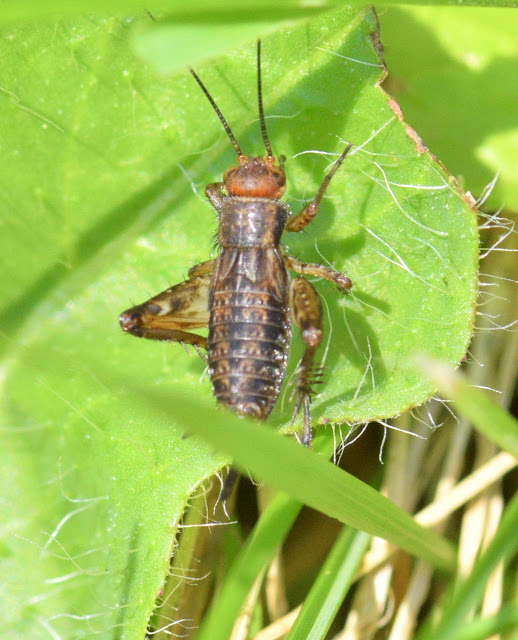Natalie Weill invited Maeve and me to her home on Nashville Road in Jericho, Vermont for a *bug safari (inverting). We spent about one hour observing a sampling of the insects and some of the diverse sets of plants on the property. See a few of what we observed in the photos below.
The property is an example of turning what was a completely mowed area into a wildlife-diverse habitat with (mowed) paths to walk along and enjoy the many life forms that now abound there.
Natalie with a found feather.
The photo titles are linked to the iNaturalist posting.
Click on the hot links for the latest ID confirmation and then click on the insect name at the top of the iNaturalist page for more information about the insect.
Id not yet confirmed
"Spotted knapweed … are native to Europe and Russia. No one is sure when brown knapweed (C. jacea) was introduced to North America. Black knapweed (C. nigra) and spotted knapweed (C. stoebe) were …::: - read more on the VT Invasive Web page.
Knapweeds are herbaceous biennials or perennials. Seedlings emerge throughout the growing season and rosettes persist year-round. Knapweeds bloom in summer with white to purple flowers. As part of the aster family, knapweeds have composite flowers with each flowerhead made up of many tiny florets. Knapweeds also have bracts at the base of their flowerheads. Characteristics of the bracts are key for distinguishing knapweed species. Seeds are dry, brown, and elliptic in shape with tufts of hair to aid wind dispersal. *Bracts are leaf-like structures that we associate most readily with flowers. They are usually located directly below the petals and enclose the precious reproductive structures as the young bud develops.
Look-alikes
Unlike perennial cornflowers, spotted knapweed has deeply lobed leaves, grayish foliage, and pink or purple florets. Spotted knapweed has smaller involucres (10 to 13 mm long) and thinner leaves than perennial cornflower.
Canada thistle’s (Cirsium arvense) flower quantity, size, and shape can be similar to knapweeds. Canada thistle leaves are noticeably spiny.
(a member of Aphideaters Genus Eupeodes)
Oleander Aphid (Aphis nerii) on a milkweed plant.
This one was on a Goldenrod plant.
We call our observation experience a bug safari, but to be more correct in our terms, this was the only true bug we observed.
The True Bugs are insects that have two pairs of wings, the front or outer pair of each divided into a leathery basal part and a membranous apical part. These wing covers are held over the back and often partly folded. True bugs have hypodermic-needle-like mouthparts that allow them to extract subsurface fluids from plants and animals. Bugs undergo incomplete metamorphosis, with their young looking much like adults, but without wings. - Smithsonian Institute
Aphid Wasps (Subfamily Pemphredoninae)
It's really been an extraordinary experience living on Nashville Rd and meeting and connecting with all the creatures that live and visit here as well. I'm thrilled to find people like you [Maeve] and Bernie who feel the magic of being part of the natural world, instead of being separate. - Natalie
Bug Safaris - Limited Time Offer
Bug Safari still has openings to help kids and families tap into their sense of wonder about nature and what species are living in their backyards. Bernie will join you at your yard (in Jericho) to photograph and help you identify the critters we find. How many insects or other LIFE species will you find living in your yard? As of June 10, Jericho ranks tenth place (of all towns and cities in VT) with 2,110 taxa posted on iNaturalist.
" Nothing is better than close observation and measurement, with some discernment about why things are as they appear, as a means of learning the ecological workings of an environment." Pond and Brook - A Guide to Nature in Freshwater Environments by Michael J. Caduto
Details
Ideally, you will have some kind of flowers (planted, wild, or even weeds) blooming at your residence.
The best time of day is around 9:30 am but I can be flexible.
Contact Bernie to schedule a 1-hour bug hunt at your Jericho address.
All ages are welcome.
I will take photos and post them on iNaturalist. You are welcome to do the same or you can also simply join in the search.
It also includes an introduction to using iNaturalist (via phone - about 15 minutes beyond the 1-hour bug hunt). (Optional)
I have observed 91 bee species nearly all of them in our 1.3-acre yard. And I have observed and posted about 1,000 insect species many if not most of them in our yard. I have observed many different insect behaviors, stages of life, and fascinating-looking creatures. What will we find in your yard? Perhaps a species never before reported in Jericho, or even in Vermont. Get to know some of your LIFE neighbors, it can be fun, interesting, and sometimes creates an OH MY GOSH.
View all observations within Jericho posted on iNaturalist at https://www.inaturalist.org/projects/biodiversity-of-jericho-vermont
Inverting (insect watching) is being outside,
observing, experiencing, the multitude,
the diversity, and the daily going ons of LIFE.
I am an 'inverter'!
Bernie













































